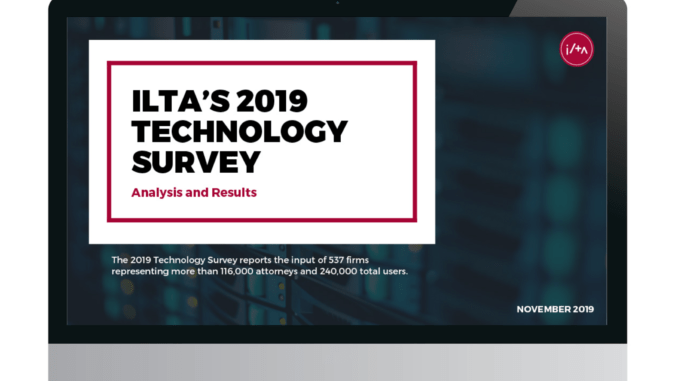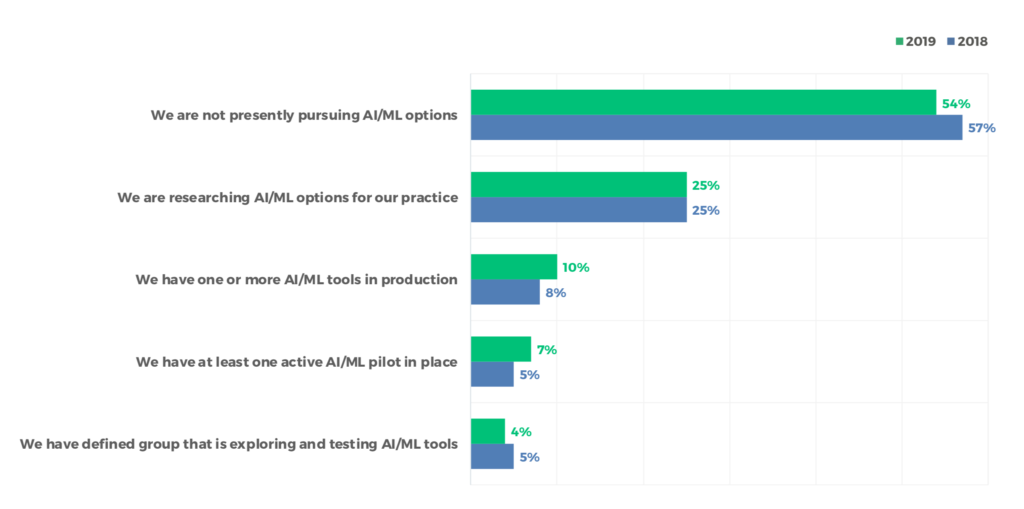
The Annual Tech Survey of the International Legal Technology Association (ILTA) is being released, and the US-based organisation has very kindly allowed Artificial Lawyer to publish one of the more AI-related snapshots from its survey across 537 law firms.
The key finding is that 54% of those who responded to this part of the survey said they were not pursuing some type of AI / machine learning option. And that is real progress.
As seen in the table below, which ILTA has allowed to be shared today, the reality is that it’s a clear minority of just 10% that have ‘one or more AI/ML tools in production’.
25% of respondents are researching the types of tools that you can place under the AI/ML umbrella, and 7% have at least one AI/ML product pilot in place.

WHAT IS YOUR FIRM’S CURRENT STRATEGY ON ARTIFICIAL INTELLIGENCE/MACHINE LEARNING (AI/ML)? [Data: ILTA Tech Survey 2019.]
While some might believe these figures to be a picture of low uptake and sluggish implementation; compared to just 2016 – the first time this site covered the ILTA tech survey – this is healthy progress.
Moreover, in a survey of 500-plus law firms of all different types, the fact that we have figures even this high is surprising, to this site at least.
To think that 17% are relying on an AI/ML tool already or doing a pilot with one, across such a wide and varied range of commercial law firms, from tiny to massive, is very positive. And, it’s worth remembering, in the US, after we get past the AmLaw 200 firms they get small very quickly. In the UK the same precipitous drop happens after about the Top 50.
I.e. the expected addressable market among law firms for many strategic level legal AI tools (i.e. doing more than just operational work) – at least in 2019 – is relatively restricted to start with.
There is room to win new clients for sure and the potential market is growing. But, this is not a retail consumer tech space. No legal AI companies, at least on the transactional side of things, are expecting to sell 1,000s of licences to law firms this year, or even hundreds. Many are looking at additional sales goals in the double figures. One or two of the smaller, newer ones may even be happy with a high single figure increase in client numbers and a handful of additional pilots.
While some relatively small firms are using, for example, AI doc review tools for bulk analysis tasks, most are not. This heavy volume work is going to tend to be the bread and butter of the very large commercial firms and ALSPs – and there is a limited number of them.
Moreover, when it comes to the big corporates and banks, who are handing out major work projects with tens of thousands of pages of unstructured data, it’s to these larger firms they are also turning. Right now, a figure much higher than that above for actual use would seem out of step with the market’s shape.
So, overall the picture is a positive one, of steady adoption and experimentation. It seems ‘normal’ now to be that way. Yet, that is a picture that seemed almost fanciful just three or more years ago. And this change will bed down and what seems to be ‘normal’ will keep evolving far faster than we may expect.
As Bill Gates, who dropped out of university to create a little startup called Microsoft, once famously said: ‘We always overestimate the change that will occur in the next two years and underestimate the change that will occur in the next ten.’
However, one thing is certain – the adoption of AI tech in the law is not going to be exponential like it was for Microsoft. It will likely remain steady and gradual, finding uptake where there are strong market drivers and macro-economic forces at work, at least that’s Artificial Lawyer’s view.
If you’d like to get your hands on the full report – and this above is just the very smallest of samples from it – then you can get hold of it here. (Note: $$$).